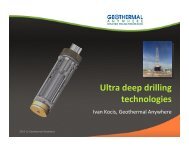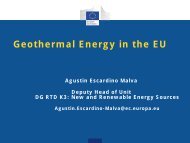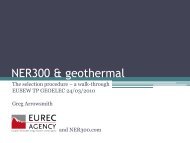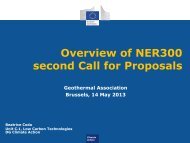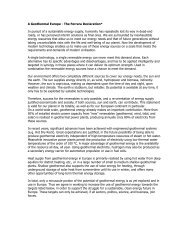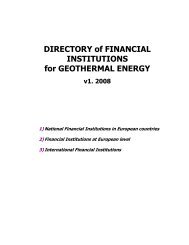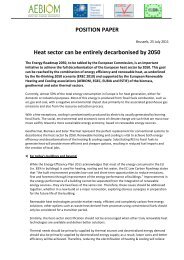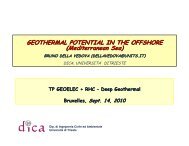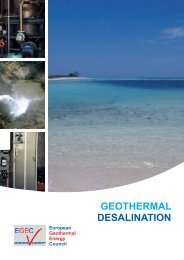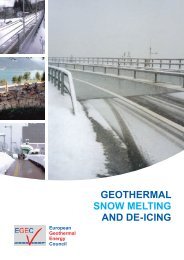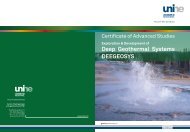Strategic Research and Innovation Agenda for Renewable ... - EGEC
Strategic Research and Innovation Agenda for Renewable ... - EGEC
Strategic Research and Innovation Agenda for Renewable ... - EGEC
Create successful ePaper yourself
Turn your PDF publications into a flip-book with our unique Google optimized e-Paper software.
3<strong>Strategic</strong> <strong>Research</strong> <strong>and</strong> <strong>Innovation</strong> <strong>Agenda</strong> <strong>for</strong> <strong>Renewable</strong> Heating & CoolingRHC applications <strong>and</strong> priorities <strong>for</strong> residential buildingsThe priorities <strong>for</strong> thermal energy storage with short term impact mostly concern sensible<strong>and</strong> latent storage:CCT.6ObjectiveNext generation of Sensible Thermal Energy StoragesAvailability of high-efficiency sensible thermal energy storage devices with significantlyreduced heat losses, efficient charging <strong>and</strong> discharging characteristics <strong>and</strong> high flexibilityto adapt it to <strong>and</strong> integrate it in existing buildings with limited space <strong>for</strong> storages.Costs <strong>and</strong> thermal conduction of the containment materials will be reduced by replacing metalwith polymer casings, with or without fibre rein<strong>for</strong>cement. Novel <strong>and</strong> compact heat exchangersusing improved concepts, geometries <strong>and</strong> perhaps new materials like polymers will improve thecharging <strong>and</strong> discharging process by increased heat transfer power <strong>and</strong> there<strong>for</strong>e reduce charging<strong>and</strong> discharging time <strong>and</strong> disturbances of the temperature stratification.Significant improvements on storage insulation will be achieved by the development of longlasting, low-cost <strong>and</strong> easy to apply high per<strong>for</strong>mance insulation materials like vacuum insulation.This will increase the overall system per<strong>for</strong>mance, the available storage volume (at the samegross volume of the storage including insulation) <strong>and</strong> the com<strong>for</strong>t <strong>for</strong> users by reduced roomheating in summer.The per<strong>for</strong>mance of sensible TES will be further increased by improved charging <strong>and</strong>discharging as well as stratification devices. The integration of sensible TES into smartheating networks will be enabled by the inclusion of intelligent state of charge determinationsystems fully integrated in the storage.State-of-the-artThe vast majority of today’s storages are based on sensible thermal energy storage,using water as the storage medium <strong>and</strong> there<strong>for</strong>e a lot of different concepts, materials<strong>and</strong> technologies <strong>for</strong> insulating <strong>and</strong> charging <strong>and</strong> discharging of the storages are available.However, the available technologies are not satisfying regarding per<strong>for</strong>mance, flexibility<strong>and</strong> costs especially since thermal storage will become much more important in the heating<strong>and</strong> cooling sector by using renewable energies.The current limitations of sensible storage technology have a major impact given that a largenumber of water stores are deployed in combination with renewable energy technology suchas solar thermal.TargetsType of activity• 20% cost reduction of mass produced containment.• High per<strong>for</strong>mance insulation materials with 50% higher insulation effect than conventionalmaterials <strong>and</strong> 70% lower cost than present vacuum insulation.30% Basic research / 40% Development / 30% Demonstration3.5.4 <strong>Research</strong> <strong>and</strong> innovation priorities <strong>for</strong> Thermal Energy Storage with impactin the Medium <strong>and</strong> Long TermThe medium to long term priorities <strong>for</strong> thermal energy storage R&D can be expressed alongthree thematic lines:• reliable <strong>and</strong> efficient system per<strong>for</strong>mance of thermal storage;• more efficient storage through improved heat transfer <strong>and</strong> heat transport;• increased storage density using phase change materials <strong>and</strong> thermochemical materials.The first line incorporates the integration <strong>and</strong> optimization of storage in the heating<strong>and</strong> cooling system, the second line aims at improving the main components in thestorage auxiliary system <strong>and</strong> the third line is dependent on materials development<strong>and</strong> improvement.CCT.7ObjectiveState-of-the-artImproving the efficiency of combined thermal energy transfer <strong>and</strong> storageFurther development <strong>and</strong> improvement of fluids that combine the heat transfer function withthermal energy storage. These will lead to smaller required storage volumes, to an increasein heat transfer efficiency <strong>and</strong> to a reduction in auxiliary energy <strong>for</strong> pumping.Low-viscosity, non-corrosive fluids capable of storing large quantities of heat <strong>and</strong> able to workat low pressure are needed <strong>for</strong> the next generation of TES systems. For medium temperatures,molten salts could offer the ultimate solution. For low temperatures, additional research isneeded on PCM slurries <strong>and</strong> PCM emulsions as well as demonstration of innovative concepts<strong>for</strong> cooling in buildings with ice slurries.Targets • PCM slurries or emulsion with long lifetime, reducing the pumping energy with 25%with respect to a conventional water based heat transfer fluid system.• A reduction of 20% of the storage volume through the use of PCM heat transfer fluids<strong>for</strong> room heating.Type of activity20% <strong>Research</strong> / 40% Development / 40% Demonstration38



